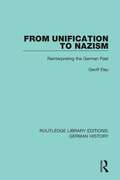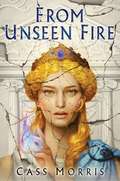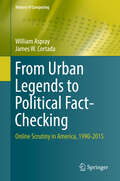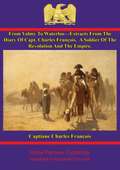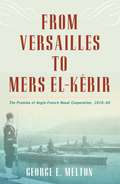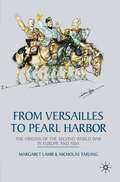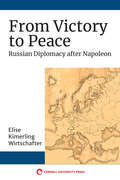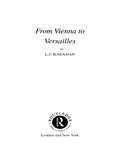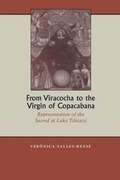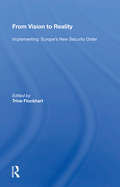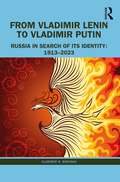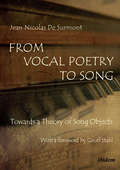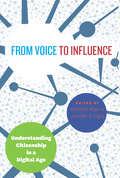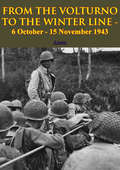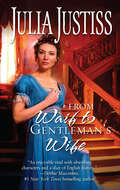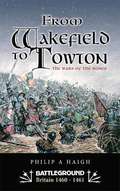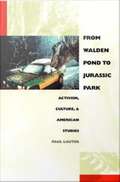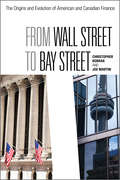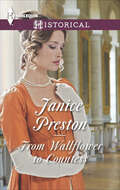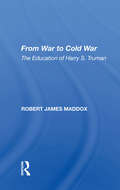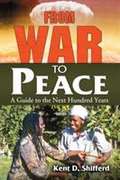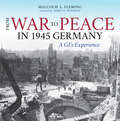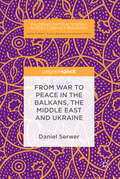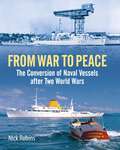- Table View
- List View
From Unification to Nazism: Reinterpreting the German Past (Routledge Library Editions: German History #9)
by Eley GeoffOriginally published in 1986, and bringing together essays written over a 10 year period, this volume offers a coherent and challenging interpretation of the German past. The book argues that the German Empire between 1971 and 1914 may have enjoyed greater stability and cohesion than is often assumed. It suggests that Imperial Germany’s political institutions showed considerable flexibility and capacity for growth and puts forward the idea that without WWI, or in the event of a German victory, the Empire might well have demonstrated its viability as a modern state. In that case, the origins of fascism should be sought mainly in the subsequent experiences of war, revolution and economic crisis and not so much in the Empire’s so-called structural backwardness.
From Unseen Fire (Aven Cycle #1)
by Cass MorrisFrom Unseen Fire is the first novel in the Aven Cycle, a historical fantasy set in an alternate Rome, by debut author Cass MorrisThe Dictator is dead; long live the Republic. But whose Republic will it be? Senators, generals, and elemental mages vie for the power to shape the future of the city of Aven. Latona of the Vitelliae, a mage of Spirit and Fire, has suppressed her phenomenal talents for fear they would draw unwanted attention from unscrupulous men. Now that the Dictator who threatened her family is gone, she may have an opportunity to seize a greater destiny as a protector of the people—if only she can find the courage to try.Her siblings—a widow who conceals a canny political mind in the guise of a frivolous socialite, a young prophetess learning to navigate a treacherous world, and a military tribune leading a dangerous expedition in the province of Iberia—will be her allies as she builds a place for herself in this new world, against the objections of their father, her husband, and the strictures of Aventan society. Latona’s path intersects with that of Sempronius Tarren, an ambitious senator harboring a dangerous secret. Sacred law dictates that no mage may hold high office, but Sempronius, a Shadow mage who has kept his abilities a life-long secret, intends to do just that. As rebellion brews in the provinces, Sempronius must outwit the ruthless leader of the opposing Senate faction to claim the political and military power he needs to secure a glorious future for Aven and his own place in history. As politics draw them together and romance blossoms between them, Latona and Sempronius will use wit, charm, and magic to shape Aven’s fate. But when their foes resort to brutal violence and foul sorcery, will their efforts be enough to save the Republic they love?
From Urban Legends to Political Fact-Checking: Online Scrutiny in America, 1990-2015 (History of Computing)
by William Aspray James W. CortadaThis text presents an historical examination of political fact-checking, highlighting how this is part of a larger phenomenon of online scrutiny that manifests itself in multiple forms. Reflecting the long history of “fake facts” in America, the book discusses important developments in this area from the emergence of the public Internet in the 1990s to the start of the Trump-Clinton presidential election campaigns.Topics and features: describes how some of the major players in political fact-checking began with the purpose of scrutinizing and debunking of urban legends; considers how this was part of a wider culture, encompassing B-grade horror movies, truth-or-fiction television shows, and groups warning about computer viruses; explains how such developments are connected, revealing political fact-checking as one of many forms of scrutiny applied in the face of a complex, dangerous world; provides a range of detailed case studies, covering such topics as the rumors surrounding the 9/11 terrorist attacks, and academic interest in contemporary legends; discusses how pre-Internet technologies such as bulletin boards, Usenet, and proprietary online service providers such as CompuServe and AOL were used to both disseminate and debunk urban legends; examines the rise of political fact-checking, reviewing all of the major initiatives in this area undertaken in the United States.This timely study touches on issues of popular culture and major events, and offers profiles of colorful individuals and organizations, and as such will appeal to a broad audience interested in the history of fact-checking and efforts to protect the political process from falsehoods.
From Valmy To Waterloo—Extracts From The Diary Of Capt. Charles François: A Soldier Of The Revolution And The Empire.
by Jules Arsène Arnaud Clarentie Robert B. Douglas Capitiane Charles FrançoisThe cannonade of Valmy (1792) ranks as one of the most significant battles of all time for its strategic results: the defeat of the Prussian invasion heralded the beginning of the French Republic. At the field of Waterloo in 1815, no less a battle ended once and for all the ambitions of Napoleon to dominate Europe under French hegemony. Throughout this period of strife and struggle, which would change the map of Europe forever, Capitaine François fought under the banners and eagles of France, a callow youth at the time of Valmy, a grizzled veteran by the time of Waterloo. His story stretches from the plains of Northern France, through the frozen wastes of Russia, the sunburnt sands of Egypt and to the rotting prisoner hulks of Spain. François was by his own account a ruthless, fearless fighter but tempered with a passionate and phlegmatic nature; of the many memoirs of Napoleon's troops, few are filled with such adventure and anecdote.An excellent from the ranks of Napoleon's army.Author -- Capitaine Charles François (1774 or 5-1853.)Preface -- Jules Arsène Arnaud Claretie (1840-1913.)Translator -- Robert B. DouglasText taken, whole and complete, from the edition published in 1906, London, by Everett and Co.Original Page Count - 332 pages.
From Versailles To Mers El-kébir: The Promise Of Anglo-french Naval Cooperation, 1919-40
by George MeltonThis is a ground-breaking study in Anglo-French naval relations after 1919 as they related to European diplomatic currents between the two World Wars, and to the balance of global naval power before World War II until the summer of 1940. The regional focus is on the Mediterranean, the only area where British and French naval power could be combined to support their diplomatic agenda and to restrain the weakest of the three Axis powers. In broader focus, the study suggests that shifting currents in the balance of global naval power left both the French and British fleets overextended in the late 1930’s, so that their concluding an entente was their only option to redress the strategic imbalance. The book is a study of the troubled courtship between the two naval staffs leading to the conclusion in early 1939 of a naval Entente. The Entente enabled London and Paris to distribute their naval power in the Mediterranean to neutralize Italy and Japan and to combine their naval power in the Atlantic against the Kriegsmarine. But that alliance was not an altogether happy one, as the global defense imperatives of the Admiralty frustrated the regional ambitions of the Rue Royale intent upon unleashing combined Anglo-French naval power against Italy to seize control of the Mediterranean early in the war. The study concludes that the Entente enjoyed its greatest success in terms of naval operations in the Atlantic against German surface raiders and U-boats, and that the British attack upon the French squadron at Mers el-Kébir was more a product of the 1940 Franco-German-Italian armistices that of accumulated tensions in the Entente. Finally, the study concludes with the view that the attack upon the French fleet at Mers el-Kébir was a tactical failure and a strategic blunder that burdened the subsequent war effort and created a naval balance more hostile than that prior to the attack, and that the outcome of the operation demanded a carefully crafted cover-up that twisted the facts and concealed from the public the failure of the operation.
From Versailles to Pearl Harbor
by Nicholas Tarling Margaret LambIn 1941, the European war became a world war. This book tackles that process in its economic, political and ideological dimensions. Margaret Lamb and Nicholas Tarling explore the significance of the Asian factor and the importance of East Asia in the making of the war in Europe and the transformation of the European war of 1939 into the world war of 1941. This Asian factor has often been neglected, but the policies of all the major powers were affected by their world-wide interests. France had its possessions in North Africa and Asia; Nazi Germany chose to become involved in China and to make an agreement with Japan; Britain's action in Europe and the Mediterranean were conditioned by its commitments elsewhere in the world, and the United States and the Soviet Union were both involved in Europe and Asia. In particular the threat that Japan presented to the status quo in East Asia made it difficult for the war in Europe in turn affected the position in East Asia. The US built a two-ocean navy and encouraged the British to continue their struggle by keeping the resources of South East Asia available, and these steps led to a clash with the Japanese. Lamb and Tarling's global approach throws valuable new light on the origins of the Second World War.
From Victims to Suspects: Muslim Women Since 9/11
by Shakira HusseinDrawing on interviews and examples from across the globe, this book tackles the shifting narratives surrounding Muslim women Once regarded as passive victims waiting to be rescued, Muslim women are now widely regarded as arbiters of "terror" and a potential threat to be kept under control. Drawing on interviews and examples from around the world including Afghanistan, Pakistan, Europe, and North America, Shakira Hussein shows how this shift in attitude has taken place and how it impacts feminism, multiculturalism, race, and religion on a global scale. She argues that alongside the fear of Islamic terrorism is a growing fear of Islam as a cultural hazard that is undermining Western society from within. Muslim women, the transmitters of cultural practices, are frequently seen to play a key role in this. Hussein’s work makes for a compelling read, offering a unique perspective on what it means to be a Muslim woman post-9/11.
From Victory to Peace: Russian Diplomacy after Napoleon (NIU Series in Slavic, East European, and Eurasian Studies)
by Elise Kimerling WirtschafterIn From Victory to Peace, Elise Kimerling Wirtschafter brings the Russian perspective to a critical moment in European political history. This history of Russian diplomatic thought in the years after the Congress of Vienna concerns a time when Russia and Emperor Alexander I were fully integrated into European society and politics. Wirtschafter looks at how Russia's statesmen who served Alexander I across Europe, in South America, and in Constantinople represented the Russian monarch's foreign policy and sought to act in concert with the allies.Based on archival and published sources—diplomatic communications, conference protocols, personal letters, treaty agreements, and the periodical press—this book illustrates how Russia's policymakers and diplomats responded to events on the ground as the process of implementing peace unfolded.Thanks to generous funding from the Sustainable History Monograph Pilot and the Mellon Foundation the ebook editions of this book are available as Open Access (OA) volumes from Cornell Open (cornellopen.org) and other Open Access repositories.
From Vienna to Versailles
by L.C.B. SeamanThis classic text examines the story of European affairs and international relations from 1850 to 1920. Authoritative and concise, it emphasizes interpretation rather than the chronological narrative of the facts.
From Viracocha to the Virgin of Copacabana: Representation of the Sacred at Lake Titicaca
by Verónica Salles-ReeseSurrounded by the peaks of the Andean cordillera, the deep blue waters of Lake Titicaca have long provided refreshment and nourishment to the people who live along its shores. From prehistoric times, the Andean peoples have held Titicaca to be a sacred place, the source from which all life originated and the site where the divine manifests its presence. <P><P> In this interdisciplinary study, Verónica Salles-Reese explores how Andean myths of cosmic and ethnic origins centered on Lake Titicaca evolved from pre-Inca times to the enthronement of the Virgin of Copaca-bana in 1583. She begins by describing the myths of the Kolla (pre-Inca) people and shows how their Inca conquerors attempted to establish legitimacy by reconciling their myths of cosmic and ethnic origin with the Kolla myths. She also shows how a similar pattern occurred when the Inca were conquered in turn by the Spanish.
From Vision To Reality: Implementing Europe's New Security Order
by Trine FlockhartFrom Vision to Reality takes the reader past the fixation with political decision-making by focusing on the process of implementation that follows important policy decisions. The book identifies the intentions behind a collection of key policy decisions for establishing Europe's new security order and investigates whether the implementation of thos
From Vladimir Lenin to Vladimir Putin: Russia in Search of Its Identity: 1913–2023
by Vladimir N. BrovkinThis book integrates Soviet and post-Soviet Russian history into a coherent whole by focusing on the culture, role models, habits and behavior patterns that provide continuity between various political regimes, systems, and rulers from Vladimir Lenin to Vladimir Putin. The unifying theme of all these periods is the central question of identity – how the Russians have defined themselves, their country, and their values. Why did the Bolsheviks try to erase any trace of Old Russia and with what did they try to replace it? Why did Stalin wipe out the kulaks and the old Bolsheviks? What were the political consequences of the Great Patriotic War on the Russians as people? When post-Stalin Russia slowly weakened and gave way to the humanism and Westernization that led to the collapse of the Soviet system, why did the 1990s generate a resurgence of anti-western nationalism? And how to explain the slow and steady break with the West under President Putin? This will be a core textbook for undergraduate and graduate students of Russian and European history, and a valuable text for all those interested in how the Russian past influenced and shaped current politics, and in the international East–West divide in particular.
From Vocal Poetry to Song: Towards a Theory of Song Objects
by Jean Nicolas SurmontAlthough the song is often the subject of monographs, one of its forms remains insufficiently researched: the vocalized song, communicated to the spectator through performance. The study of the song takes one back to the study of vocal practices, from aesthetic objects to forms and to plural styles. To conceive a song means approaching it in its different instances of creation as well as its linguistic diversity. Jean Nicolas De Surmont proposes ways of research and analysis useful to musicians, musicologists, and literary critics alike. He takes up the issue of vocal poetry in addition to examining the theoretic aspects of song objects. Rather than offering an autonomous model of analysis, De Surmont extends the research fields and suggests responses to debates that have involved everyone interested in vocal poetic forms.
From Voice to Influence: Understanding Citizenship in a Digital Age
by Jennifer S. Light Danielle Allen and Jennifer S. LightHow have online protests—like the recent outrage over the Komen Foundation’s decision to defund Planned Parenthood—changed the nature of political action? How do Facebook and other popular social media platforms shape the conversation around current political issues? The ways in which we gather information about current events and communicate it with others have been transformed by the rapid rise of digital media. The political is no longer confined to the institutional and electoral arenas, and that has profound implications for how we understand citizenship and political participation. With From Voice to Influence, Danielle Allen and Jennifer S. Light have brought together a stellar group of political and social theorists, social scientists, and media analysts to explore this transformation. Threading through the contributions is the notion of egalitarian participatory democracy, and among the topics discussed are immigration rights activism, the participatory potential of hip hop culture, and the porous boundary between public and private space on social media. The opportunities presented for political efficacy through digital media to people who otherwise might not be easily heard also raise a host of questions about how to define “good participation:” Does the ease with which one can now participate in online petitions or conversations about current events seduce some away from serious civic activities into “slacktivism?” Drawing on a diverse body of theory, from Hannah Arendt to Anthony Appiah, From Voice to Influence offers a range of distinctive visions for a political ethics to guide citizens in a digitally connected world.
From Volturno To The Winter Line: 6 October - 15 November 1943 [Illustrated Edition]
by AnonIllustrated with 30 maps and 36 Illustrations.BEFORE DAWN ON THE MORNING OF 13 Oct. 1943, American and British assault troops of the Fifth Army waded the rain-swollen Volturno River in the face of withering fire from German riflemen and machine gunners dug in along the northern bank. This crossing of the Volturno opened the second phase of the Allied campaign in Italy. Five weeks earlier the Fifth Army had landed on the hostile beaches of the Gulf of Salerno. Now it was attacking a well-defended river line.Along the Volturno the Germans had entrenched themselves in the first good defensive position north of Naples. Under pressure from the Fifth Army, commanded by Lt. Gen. Mark W. Clark, their rearguards had relinquished the great port of Naples with its surrounding airfields, providing us with the base necessary for large-scale operations west of the rugged Apennine mountain range, backbone of the Italian peninsula. East of the Apennines the British Eighth Army, under General Sir Bernard L. Montgomery, had reached the mouth of the Biferno River during the first week of Oct.. The Eighth and Fifth Armies now held a line across the peninsula running south from Torre Petacciato on the Adriatic Sea for some sixty-five miles, then west to a point on the Tyrrhenian Sea just south of the Volturno. Along this line of rivers and mountains the Germans clearly intended to make a stubborn stand, hoping to delay, perhaps to stop, our northward advance.Within six weeks, Fifth Army troops had driven the Germans back to the Volturno, had executed a difficult river crossing in the face of a well-entrenched enemy, had gone on to cross the river a second and a third time, and had forced Kesselring's hard-pressed army back into the chain of mountains which formed his next strong defensive position. Whether fighting across rivers, through valleys, or up steep mountain slopes, our men had everywhere proved their ability to defeat Hitler's vaunted master race.
From Waif to Gentleman's Wife (The Wellingfords #5)
by Julia JustissA struggling widow’s new employment comes with a handsome benefit in this dramatic Regency romance.When a destitute governess faints on Sir Edward Greaves’s threshold, chivalry demands that he offer her temporary shelter. However, the desire Ned feels when he catches her in his arms isn’t at all gentlemanly. . . . With her large, troubled eyes and slender frame, Joanna Merrill calls to something deep inside this guarded man. For one who has purposely shunned the conniving beauties of London society, just how much is Ned risking by having this intriguing woman under his roof . . . ?Praise for From Waif to Gentleman’s Wife“An enjoyable read with absorbing characters and a slice of English history.” —Debbie Macomber, #1 New York Times–bestselling author“Justiss not only sets her expertly crafted story in the English countryside in the midst of industrialization but she also authentically portrays ordinary people, whose lives do not center around the ton, thus giving this Regency historical a delightfully different twist.” —Booklist“Emotionally charged and heartwarming, as two lonely hearts fall in love, only to be ripped asunder by secrets and betrayal.” —Romantic Times
From Wakefield to Towton: The Wars of the Roses (Battleground Britain 1460–1461)
by Philip HaighThe Wars of the Roses was a complicated, bloody affair between the houses of Lancaster and York, and witnessed much changing of sides. That disjointed feuding persisted for a staggering thirty years and was a north versus south affair. However, the period and conflicts covered by this title are refreshingly clear. An intriguing tale of treachery and deceit.
From Walden Pond to Jurassic Park: Activism, Culture, & American Stduies
by Paul LauterPaul Lauter, an icon of American Studies who has been a primary agent in its transformation and its chief ambassador abroad, offers a wide-ranging collection of essays that demonstrate and reflect on this important and often highly politicized discipline. While American Studies was formerly seen as a wholly subsidiary academic program that loosely combined the study of American history, literature, and art, From Walden Pond to Jurassic Park reveals the evolution of an independent, highly interdisciplinary program with distinctive subjects, methods, and goals that are much different than the traditional academic departments that nurtured it. With anecdote peppered discussions ranging from specific literary texts and movies to the future of higher education and the efficacy of unions, From Walden Pond to Jurassic Park entertains even as it offers a twenty-first century account of how and why Americanists at home and abroad now do what they do. Drawing on his forty-five years of teaching and research as well as his experience as a political activist and a cultural radical, Lauter shows how a multifaceted increase in the United States' global dominion has infused a particular political urgency into American Studies. With its military and economic influence, its cultural and linguistic reach, the United States is--for better or for worse--too formidable and potent not to be understood clearly and critically.
From Wall Street to Bay Street: The Origins and Evolution of American and Canadian Finance
by Joe Martin Chris KobrakThe 2008 financial crisis rippled across the globe and triggered a worldwide recession. Unlike the American banking system which experienced massive losses, takeovers, and taxpayer funded bailouts, Canada’s banking system withstood the crisis relatively well and maintained its liquidity and profitability. The divergence in the two banking systems can be traced to their distinct institutional and political histories. From Wall Street to Bay Street is the first book for a lay audience to tackle the similarities and differences between the financial systems of Canada and the United States. Christopher Kobrak and Joe Martin reveal the different paths each system has taken since the early nineteenth-century, despite the fact that they both originate from the British system. The authors trace the roots of each country’s financial systems back to Alexander Hamilton and insightfully argue that while Canada has preserved a Hamiltonian financial tradition, the United States has favoured the populist Jacksonian tradition since the 1830s. The sporadic and inconsistent fashion in which the American system have changed over time is at odds with the evolutionary path taken by the Canadian system. From Wall Street to Bay Street offers a timely and accessible comparison of financial systems that reflects the political and cultural milieus of two of the world’s top ten economies.
From Wallflower to Countess
by Janice PrestonCan a wilting wallflower be transformed by a marriage of convenience?Most girls would dream of marriage to the dashing Earl of Stanton, darling of the ton. For plain Lady Felicity Weston, who is used to being ignored and overlooked, it’s a terrifying prospect! Richard thought love was for fools. Although, after an explosive wedding night, he’s intrigued by his shy new bride. Day by day the tentative trust between these newlyweds grows. But the stakes in this marriage of convenience are raised when Felicity falls pregnant . . . Will giving the earl an heir finally help this wallflower blossom into a confident countess?Praise for Janice Preston’s novels“Enthralling . . . captures the reader’s attention from the first page.” —Chicks, Rogues and Scandals“A richly romantic, character-driven story.” —All About Romance
From War To Cold War: The Education Of Harry S. Truman
by Robert James MaddoxThis book reviews the strains between the United States and Great Britain that led to the Cold War as the result of personal characteristics of the leaders of the United States, the Soviet Union, and Great Britain as well as of historical and ideological forces.
From War To Peace: A Guide To The Next Hundred Years
by Kent D. ShifferdThe world's first peace organizations emerged in the 19th century and since that time, anti-war activism has progressed rapidly. This illuminating book presents a realistic analysis of the extent to which the war system has infiltrated all aspects of Western culture and how it works to perpetuate war rather than promote peace. Additionally, the text describes the historically recent and still evolving parallel system of peace institutions. The values and ideas that have grown out of peace activism offer a very real opportunity to outlaw war in the coming century just as slavery was abolished in the 19th century.
From War to Peace in 1945 Germany
by James H. Madison Bradley D. Cook Malcolm L. FlemingAs an Official Army Photographer, "Mac" Fleming's assignment was to take motion pictures of significant wartime events for the US Army. In the pouch intended to carry his first-aid kit on his belt, he instead carried a small personal camera, which he used to take pictures of the people and places that interested him, capturing in his field notes details of the life he observed. From these records, Fleming has assembled this absorbing private chronicle of war and peace. Assigned to the European Theater in February 1945, he filmed the action from the battle for the Remagen Bridge across the Rhine, to the fighting in the Hartz Mountains, on to the linkup with the Russian forces at the Elbe River. After the armistice, Fleming helped document how the Allied Expeditionary Force established a military government in Germany to cope with masses of POWs, establish control of the country, deal with the atrocities committed by the German army, and help thousands of newly released slave laborers return home to Poland, France, and Russia. He also recorded how the army provided rest, recreation, and rehabilitation to the remaining US soldiers and sent them home by truck, train, and ship. Awaiting shipment home, Fleming explored postwar German town and country life and toured some famous castles and historic spots. The foreword by historian James H. Madison describes the important role of photography in war and the special contribution of Fleming's photographic diary.
From War to Peace in the Balkans, the Middle East and Ukraine (Palgrave Critical Studies in Post-Conflict Recovery)
by Daniel SerwerThis open access book focuses on the origins, consequences and aftermath of the 1995 and 1999 Western military interventions that led to the end of the most recent Balkan wars. Though challenging problems remain in Bosnia, Macedonia, Kosovo, and Serbia, the conflict prevention and state-building efforts thereafter were partly successful as countries of the region are on separate tracks towards European Union membership. This study highlights lessons that can be applied to the Middle East and Ukraine, where similar conflicts are likewise challenging sovereignty and territorial integrity. It is an accessible treatment of what makes war and how to make peace ideal for all readers interested in how violent international conflicts can be managed, informed by the experience of a practitioner.
From War to Peace: The Conversion of Naval Vessels After Two World Wars
by Nick RobinsFrom War to Peace tells the story of the adaptation from White Ensign to Red Ensign, and to flags of other nations, of the numerous classes of naval ships mainly built during the two world wars and surplus to requirements with the advent of peace. It also describes ships sourced from the United States Navy and elsewhere that were converted for commercial use. The most successful classes to transfer to the merchant service were the Hunt-class minesweepers of the Great War, Landing Craft, Tank, the salvage tugs of World War Two, and the wooden-hulled Fairmile launches which became familiar at seaside resorts in the 1950s and ‘60s; and, of course, the MFV classes that helped the fishing industry in the postwar years. The story includes the successful commercial conversions of many of the Flower and Castle Class corvettes and River Class frigates, notably the 1954 conversion of HMCS Stormont to a luxury yacht for the Greek shipping magnate Onassis. It describes why HMS Charybdis became a passenger liner in the Great War, and how HMS Albatross nearly became a luxury liner after World War Two, but in fact was transformed into a very unpopular emigrant ship and ended her days as a floating casino based at Cape Town. The author reveals the military antecedents of numerous commercial vessels that many would have thought were built especially for the service that they later maintained, and it illustrates just how many Royal Navy vessels ended up in private ownership. And the question is asked: if the military had not built so many ships that were eminently suitable for commercial adaptation, would the technical development of merchant shipping have progressed at a faster rate than it did? The answer is a definite ‘no’, and is illustrated in several ways. It was former naval vessels that promoted the early development of the Ro-Ro ferry; former naval ships introduced numerous design innovations, for example, the raised foredeck common for so many years on salvage tugs, and, above all, stripped of their military hardware, ex naval ships provided opportunities for modest investment where otherwise there would have been none. Copiously illustrated throughout, the book tells a fascinating story of invention and ingenious ship conversion, and of pragmatic adaptation in the financially stringent years after two world wars.
